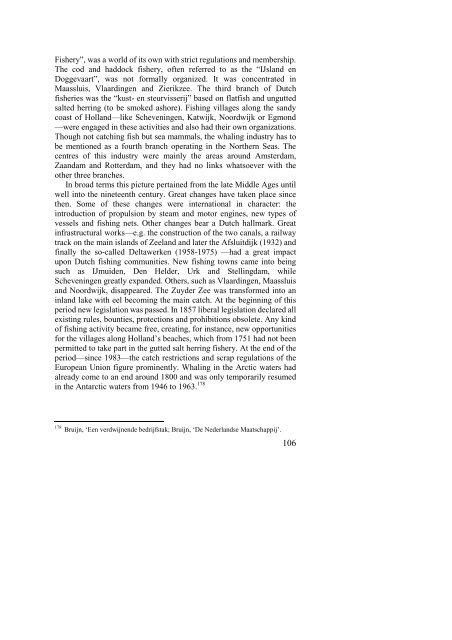The North Atlantic Fisheries, 1100-1976 - University of Hull
The North Atlantic Fisheries, 1100-1976 - University of Hull
The North Atlantic Fisheries, 1100-1976 - University of Hull
Create successful ePaper yourself
Turn your PDF publications into a flip-book with our unique Google optimized e-Paper software.
Fishery”, was a world <strong>of</strong> its own with strict regulations and membership.<br />
<strong>The</strong> cod and haddock fishery, <strong>of</strong>ten referred to as the “IJsland en<br />
Doggevaart”, was not formally organized. It was concentrated in<br />
Maassluis, Vlaardingen and Zierikzee. <strong>The</strong> third branch <strong>of</strong> Dutch<br />
fisheries was the “kust- en steurvisserij” based on flatfish and ungutted<br />
salted herring (to be smoked ashore). Fishing villages along the sandy<br />
coast <strong>of</strong> Holland—like Scheveningen, Katwijk, Noordwijk or Egmond<br />
—were engaged in these activities and also had their own organizations.<br />
Though not catching fish but sea mammals, the whaling industry has to<br />
be mentioned as a fourth branch operating in the <strong>North</strong>ern Seas. <strong>The</strong><br />
centres <strong>of</strong> this industry were mainly the areas around Amsterdam,<br />
Zaandam and Rotterdam, and they had no links whatsoever with the<br />
other three branches.<br />
In broad terms this picture pertained from the late Middle Ages until<br />
well into the nineteenth century. Great changes have taken place since<br />
then. Some <strong>of</strong> these changes were international in character: the<br />
introduction <strong>of</strong> propulsion by steam and motor engines, new types <strong>of</strong><br />
vessels and fishing nets. Other changes bear a Dutch hallmark. Great<br />
infrastructural works—e.g. the construction <strong>of</strong> the two canals, a railway<br />
track on the main islands <strong>of</strong> Zeeland and later the Afsluitdijk (1932) and<br />
finally the so-called Deltawerken (1958-1975) —had a great impact<br />
upon Dutch fishing communities. New fishing towns came into being<br />
such as IJmuiden, Den Helder, Urk and Stellingdam, while<br />
Scheveningen greatly expanded. Others, such as Vlaardingen, Maassluis<br />
and Noordwijk, disappeared. <strong>The</strong> Zuyder Zee was transformed into an<br />
inland lake with eel becoming the main catch. At the beginning <strong>of</strong> this<br />
period new legislation was passed. In 1857 liberal legislation declared all<br />
existing rules, bounties, protections and prohibitions obsolete. Any kind<br />
<strong>of</strong> fishing activity became free, creating, for instance, new opportunities<br />
for the villages along Holland’s beaches, which from 1751 had not been<br />
permitted to take part in the gutted salt herring fishery. At the end <strong>of</strong> the<br />
period—since 1983—the catch restrictions and scrap regulations <strong>of</strong> the<br />
European Union figure prominently. Whaling in the Arctic waters had<br />
already come to an end around 1800 and was only temporarily resumed<br />
in the Antarctic waters from 1946 to 1963. 178<br />
178 Bruijn, ‘Een verdwijnende bedrijfstak; Bruijn, ‘De Nederlandse Maatschappij’.<br />
106















